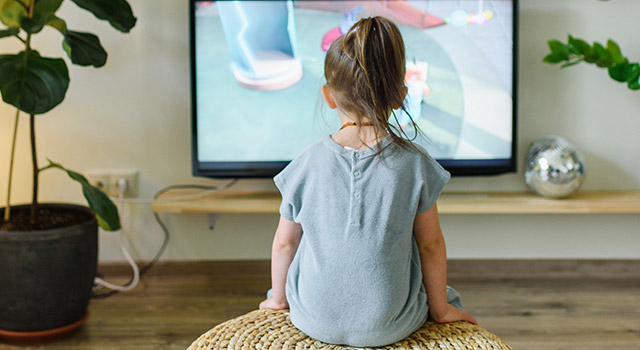 Many of us are spending more time in front of screens, and kids are no exception. Kids socialize on their phones and play video games, and may have spent a large part of the covid pandemic learning online.
Many of us are spending more time in front of screens, and kids are no exception. Kids socialize on their phones and play video games, and may have spent a large part of the covid pandemic learning online.
However, research has shown that too much screen time is unhealthy for adults and kids. For this reason, it’s important to teach children to adopt healthy screen-time habits.
How Does Screen Time Affect the Eyes?
The Royal College of Pediatrics and Child Health study (2019), found that excessive screen time was linked to higher obesity rates, and a tendency to eat more junk foods and exercise less.
The eyes, in particular, are adversely affected by hours spent in front of the screen. This is because screens emit blue light, which has shorter wavelengths and more energy than regular light, and the intensity of the light strains the eyes. There are also questions concerning the damage it can cause to the retina.
Screen time has also been linked to higher levels of myopia in young people, according to an Anglia Ruskin University study (2021). Extensive time spent texting or watching videos on a phone led to a 30% higher risk of myopia, or nearsightedness, in young people, and combined with excessive computer use, the risk rose to 80%.
Another worrying factor is excessive exposure to blue light on the circadian rhythm, an internal clock that indicates when we should be asleep or awake. Hours of blue light exposure prior to going to bed can throw off these patterns and interfere with sleep.
How to Reduce Your Child's Screen Time
Now the question is how should you implement these new rules? Here are 5 tips to help your child develop healthy habits while they’re still young, and help them preserve their mental and physical well-being, as well as their vision.
Set Limits
Set rules that are clear and easy to adhere to. Think about the number of hours per day you're willing to allow your children to use the screen either for fun or for homework—factoring in a bit extra for holidays and weekends. For instance, one 1 hour per day during the week and 2-3 on the weekends. Also consider times that should be screen-free, such as during meals, before completing homework or chores, or an hour or two before bedtime.
Get Into a Routine
Once you’ve determined how much screen time should be permitted, create a routine that is manageable and easy to stick to. Setting a structure will reduce disagreements because everyone will know what's expected of them. We recommend writing up the rules and posting them near the computer or in the family room.
For instance, assign each child an hour of screen time a day and ask them to sign up for specific slots. Leave the dinner hour vacant so no one is using screens at the time.
Set An Example
Setting rules specifying when screen time is allowed and for how long is fairly simple, but following them is a whole other thing! Modeling behavior can positively influence your kids, as they are more likely to abide by the rules if they see you setting limits on your screen time as well. Working together to limit screen time can engender a feeling of cooperation and shared goals. Instead of texting or scrolling or watching videos, spend more time together as a family doing things everyone enjoys.
Discuss WHY Screen Time Should Be Limited
Kids should not only know what the rules are but the reasons behind them. Discuss why it's important to reduce screen time, including health issues that can arise, and explain how too much blue light can affect their eyes. Understanding the reasons behind rules can make them easier to follow.
Encourage Physical Activity, Particularly Outdoors
Your child might forget about screen time when engaged in fun activities that get the body moving. In fact, several studies have shown that children who spend a significant amount of time playing outdoors lower their risk of developing myopia (nearsightedness). Other studies have linked “near work,” such as reading and spending too much time on digital devices, to the development and progression of myopia. Myopia is more than simply an inconvenient eye condition that requires frequent correction—it can have serious sight-threatening consequences in adulthood. Namely, macular degeneration, retinal detachment, glaucoma, and even cataracts. The faster the progression, and the younger the child, the greater the risk!
So encourage your child to play outdoors for at least 30-60 minutes each day, with siblings, friends or as part of a sports team. Perhaps you can take a walk or a bike ride with them after work, or throw a Frisbee — essentially helping them get into the habit of having fun without depending on screens.
If your child has already developed myopia and you want to limit its progression, contact us today. our optometric team at Eye Vision Associates can help reduce or slow down myopia progression so they can live their best life.
Our practice serves patients from Nesconset, Ronkonkoma, Lake Grove, and Centereach & Hauppauge, New York and surrounding communities.
Q: Does blue light affect myopia?
- A: A study in the International Journal of Ophthalmology (2018) has shown a link between extended exposure to blue light and nearsightedness or myopia. That's because blue light has a shorter wavelength and its high frequency penetrates the front of the retina, and can potentially lead to nearsightedness. That said, there's still more research to be done on the link between the two.
Q: What is myopia management necessary?
- A: Myopia management helps slow myopia progression using specific proven treatments methods. This also involves making lifestyle changes, such as reducing screen time and spending more time outdoors. The goal is to keep the level of myopia as low as possible in order to reduce your child's risk of developing vision-threatening eye diseases later in life.
- References
